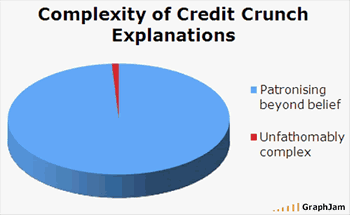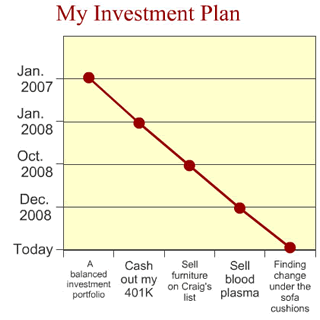Here a new time-waster: From the creators of LOLCats, GraphJam allows users to create charts that are funny and vote up the best ones. Two appropriate ones:

I guess this explanation is patronizing then? And after yesterday…

(Yes, the x- and y- axes should be reversed…)
I’m sure one of you all could think of something funnier… 🙂
 The Best Credit Card Bonus Offers – 2025
The Best Credit Card Bonus Offers – 2025 Big List of Free Stocks from Brokerage Apps
Big List of Free Stocks from Brokerage Apps Best Interest Rates on Cash - 2025
Best Interest Rates on Cash - 2025 Free Credit Scores x 3 + Free Credit Monitoring
Free Credit Scores x 3 + Free Credit Monitoring Best No Fee 0% APR Balance Transfer Offers
Best No Fee 0% APR Balance Transfer Offers Little-Known Cellular Data Plans That Can Save Big Money
Little-Known Cellular Data Plans That Can Save Big Money How To Haggle Your Cable or Direct TV Bill
How To Haggle Your Cable or Direct TV Bill Big List of Free Consumer Data Reports (Credit, Rent, Work)
Big List of Free Consumer Data Reports (Credit, Rent, Work)
Thisisindexed.com is another fantastic chart site. They specialize in diagrams. I do love graphjam and the other lolcat affiliates. I post my favorites from graphjam and failblog.org on twitter all the time.
The great thing about “My Investment Plan” is that “Finding change under the sofa cushions” just won’t work, because we sold all the furniture on Craigslist back in October. Oh, well, back to the drawing board…
Maybe it’s time you made a post that lets the responsible people get in on all these hot deals given to the irresponsible people (without losing their money, of course).
If they can get rewarded for their AWESOME financial decisions, why can’t we?
Thanks a lot, Jonathan. There goes an hour of my life, rating funny graphs!
ttfitz,
That’s hilarious!
There were news about 16.000.000.000.000. toxic derivative debt in
EU.
Well, I say there isn’t any other way as to nullify those on the basis
of common sense. Nobody would by some right to owe more then
he paid for.
In writing options you are obliged possiblly more than you got.
In buying toxic der. you paid to be in debt. It is insane.
@Derivativation:
“Well, I say there isn’t any other way as to nullify those on the basis
of common sense. Nobody would by some right to owe more then
he paid for.”
This would cause virtually every bank that holds these “toxic derivatives” i.e. CDOs (collaterized debt obligations) to fail. It will also be the same as stealing money from everyone who bought them.
CDOs represent a collection of mortgages, bonds or other debt instruments. They earn interest – e.g. mortgages that are still current. When there is a foreclosure, there is some recovery e.g. when the house is sold. As “toxic” as this obligations are, they aren’t entirely worthless. Right now they are considered “toxic” because a) nobody has a clue what the correct risk rating is and nobody can trust even AAA paper b) nobody knows how many more mortgages will fail c) when the resale value of a CDO goes down, banks holding them have to report this loss in value as a real loss and put more money in reserve to compensate. This causes banks to sell CDOs (even if they would’ve rather kept them and collected interest), and that drives the current market of CDOs even further down. The last item – banks’ need to write down loss in CDO value every quarter is the main reason these derivatives are considered “toxic” – for the banks. But just because you are afraid of something you own to lose value doesn’t mean having this value go to 0 will help.
So now, the CDOs are sold for, for example, 20 cents on a dollar or 50 cents on a dollar – I don’t know for how much – but their value can drop. What you are suggesting is to nullify them – i.e. bring their value to 0? So every CDO holder will lose all the money invested in them, all the potential cash flow from interest, etc? How will this help?
Additionally, for most CDOs out there there are Credit Default Swaps – kind of an “insurance” you can buy for when loans represented by CDOs default or something bad happens – like your “nullification”. Now, Credit Default Swaps differ from insurance in an important way — you don’t have to own a CDO to buy insurance for it. In fact, there may be several such “insurance policies” for a single CDO. When you nullify all CDOs, the holders of corresponding Credit Default Swaps need to be paid. Which means all the insurance companies (like AIG) and banks that sold Credit Default Swap will go out of business too – as they don’t have enough money to cover all the losses.
“In writing options you are obliged possiblly more than you got.”
Options aren’t the same as CDOs. You buy or write options for stocks, for example. What does it have to do with CDOs? Also, nope, you aren’t necessarily “obliged more than you got”.
“In buying toxic der. you paid to be in debt. It is insane.”
How? You can buy “toxic der.” with your real not borrowed money. This means you buy a collection of I.O.Us i.e. somebody else’s debt. You are no more “paid to be in debt” when you buy a CDO then when you buy an individual bond. Someone owes money to you, not the other way around.
Now, some investment banks were over-leveraged when they bought CDOs. But this is what it means for banks: they got $40 from your deposit. They lent out $39 and packaged these loans up in various derivative instruments. So banks are now leveraged 40 to 1 i.e. for every $40 they owe their depositors, then only have $1 in reserve.
On the other hand people who bought these CDOs from banks – including some little Norwegian village invested real, not borrowed money into them. They aren’t in debt, they own somebody else’s debt. Now, they undoubtedly made a bad investment, but it doesn’t mean you can just come and reduce the value of their investment to 0.
Either I didn’t understand what you were trying to say or you don’t have a clear understanding of the crisis.